What Was Arthur Doves Most Famous Piece of Art
| Arthur Garfield Pigeon | |
|---|---|
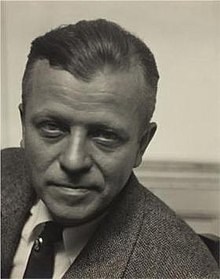 | |
| Born | (1880-08-02)August 2, 1880 Canandaigua, New York |
| Died | November 23, 1946(1946-xi-23) (aged 66) Huntington, New York |
| Nationality | American |
| Known for | Modernism, abstract art |
Arthur Garfield Dove (August ii, 1880 – November 23, 1946) was an American artist. An early on American modernist, he is often considered the get-go American abstract painter.[1] Dove used a wide range of media, sometimes in unconventional combinations, to produce his abstractions and his abstruse landscapes. Me and the Moon [2] from 1937 is a good example of an Arthur Pigeon abstruse mural and has been referred to as one of the culminating works of his career.[3] Pigeon did a series of experimental collage works in the 1920s.[4] He also experimented with techniques, combining paints similar hand mixed oil or tempera over a wax emulsion as exemplified in Dove's 1938 painting Tanks, in the collection of the Boston Museum of Fine Arts.[5]
Youth and education [edit]

Dove was born to a wealthy family in Canandaigua, New York. His parents, William George and Anna Elizabeth, were of English beginnings. William Dove was interested in politics and named his son Arthur Garfield, after the Republican candidates for president and vice-president in the 1880 election, James Garfield and Chester Arthur, who ultimately won the vote.[six] [vii] Arthur Dove grew up loving the outdoors on a subcontract; however, his male parent was a very successful businessman who owned a brickyard (along with city real manor) and expected his son to go wealthy.[viii] Dove's babyhood interests included playing the pianoforte, painting lessons, and being a pitcher on a high school baseball game team.[8] As a child, he was befriended by a neighbour, Newton Weatherby, a naturalist who helped class Dove's appreciation of nature. Weatherby was as well an amateur painter who gave Dove pieces of leftover canvas to work with.
Pigeon attended Hobart College and Cornell University, and graduated from Cornell in 1903.[1] Dove was chosen to illustrate the Cornell University yearbook. Dove'due south illustrations proved popular considering they brought life to the characters and situations they depicted.[viii] Afterward graduation, he became a well known commercial illustrator in New York City, working for Harper's Magazine and The Saturday Evening Post.[1] Dove'due south parents were upset at his choice to become an creative person, instead of a more than profitable profession that his Ivy League degree would have enabled, and they would prove unsympathetic to the difficulties that came with a career in art.[9]
Europe [edit]

In 1907, Dove and his starting time wife, Florence, traveled to France and moved to Paris, then the world's art capital.[ix] They made brusk trips to both Italia and Espana.[6] While there, Pigeon joined a group of experimental artists from the United States, which included Alfred Henry Maurer. Dove and Maurer remained friends until Maurer's suicide in 1932. While in Europe, Dove was introduced to new painting styles, in item the Fauvist works of Henri Matisse, and he exhibited at the annual Autumn Salon in 1908 and 1909. Feeling a clearer sense equally an artist, he returned to New York.[vi] His return to commercial illustration was unsatisfying, so Dove moved out of New York to brand a living off farming and fishing while devoting the rest of his fourth dimension to painting.[6] His son, William C. Dove, was born on July 4, 1909.[seven]
Stieglitz and New York [edit]
When Dove returned to America in 1909 he met Alfred Stieglitz, probably by way of Maurer'south written introduction.[vi] Stieglitz was a well known lensman and gallery owner who was very active in promoting modern fine art in America, including works by European artists that had never been seen earlier in the U.S.[vi] Dove decided to quit working as an illustrator merely was in need of artistic identity along with emotional bolstering and Stieglitz filled both these roles.[10] The photographer was sixteen years older than Dove and his urban, Jewish and European cultural roots were in dissimilarity to Dove's rural Anglo-Saxon Protestant heritage. Dove was said to exist gentle, quiet, and a good friend while Stieglitz was known every bit being belligerent and shrewd.[half-dozen] They establish their common ground in the thought that art forms should embody modernistic spiritual values, not materialism and tradition.[ix] With Stieglitz'southward support, Pigeon produced what are known equally the first purely abstract paintings to come out of America. Dove's works were based on natural forms and he referred to his type of brainchild as "extraction" where, in essence, he extracted the essential forms of a scene from nature.
Dove exhibited his works at Stieglitz's 291 gallery in 1910 as part of the show "Younger American Painters", which besides included Pigeon's one-time friend Maurer.[6] Dove showed one painting, a large even so life painted in France entitled "The Lobster", which would be his last representational work.[half dozen] Stieglitz provided Dove with his first one-homo show in 1912 at the 291.[i] The testify, which included a group of Dove'due south pastels that came to exist known as "The 10 Commandments", was the first public exhibition of abstract art by an American.[6] In the 2 years after meeting Stieglitz, Dove became a leader in international fine art developments.[6] From 1912 to 1946 Pigeon showed his piece of work annually at Stieglitz'southward galleries: 291, Intimate Gallery, and An American Place.[half dozen] Pigeon used a wide range of media over the course of his career, sometimes in anarchistic combinations. During the 1920s Dove made many works on newspaper such equally the pastel on paper, Nature Symbolized (or Reefs) from 1924. Equally stated above Dove did experimental collage works in the 1920s in works similar The Critic, 1925, and The Intellectual 1925;[11] [12] and he experimented with techniques, combining paints like oil and/or tempera over a wax emulsion. Tanks, 1938 is an case of oil over a wax emulsion; commenting nigh Tanks, the Boston Museum of Fine Arts says: Set up off by a halo of pale gray, the quivering structures about seem to dematerialize and merge into the surrounding scenery, notwithstanding at the aforementioned time, they retain their hulking forms. [5]

Patronage from Duncan Phillips [edit]
In spite of support from diverse members of the art community, it was often necessary for Dove to earn money through farming, fishing and commercial illustration. Pigeon's most consistent supporter was Duncan Phillips, founder of the Phillips Collection in Washington, D.C., which now holds the majority of Pigeon's piece of work. Dove'south work convinced Philips that abstract was an artistic procedure, non simply an art style.[13] Stieglitz'southward gallery was commencement visited by Phillips considering of Dove, and he continued to render to see Pigeon's piece of work.[xiii] In exchange for beginning pick of paintings from each exhibition, Phillips paid Dove a committee of $50.00 a month.[10] Dove met Phillips simply once in his lifetime, in 1936.[6] In 1937 Phillips purchased Goin Fishin for $2,000.00, then the largest sum paid for any of Dove's work.[six] Phillips also purchased "Huntington Harbor 1."[13] Pigeon produced almost xx-five assemblages betwixt 1924 and 1930.[7]
Dove and Helen Torr [edit]

Dove spent seven years on a houseboat called Mona with Helen Torr, known as "Reds" for the fiery color of her hair. Torr was besides a painter. Although the psychological consequences benefited Dove's art, his life with Torr was hard. Florence Pigeon had never cared virtually Dove'due south passion for art, and was more socially inclined. Subsequently 25 years of matrimony, Pigeon left Florence.[6] Florence would not grant him a divorce and flatly refused to let him run across his son.[vi] When he departed, he left behind everything except his copies of Camera Piece of work and Stieglitz's messages.[6]
When Florence died unexpectedly, Dove paid $250 for the funeral expenses and sent flowers, but did not go to the funeral in Geneva.[half-dozen] Although distressed about her death, he was at present able to see his son and marry Torr. For the commencement time in eight years, Pigeon met with his then nineteen-year-former son, Nib, who was also an artist. The two established a friendship and afterwards in life his son helped Dove with creating a technique for silvering frames.
Dove and Torr were not able to wed immediately as Torr had not divorced her first husband. They did eventually marry in April 1932 in the New York City Hall with a brief service and using a dimestore ring.[6] Dove identified himself as a "frame maker" on his marriage registry. The 1933 Gallery 291 exhibition was the merely time Stieglitz allowed Torr and Dove to showroom together.[vii] "7 Americans" brought Pigeon dorsum into the coverage of major newspapers and fine art magazines, besides every bit back into the public eye.[vi] His piece of work influenced later abstruse landscape painters, such as Julian Hatton and Georgia O'Keeffe, in having "an unbridled love of pure, hot color."[14]
Arthur Dove-Helen Torr Cottage [edit]
| Arthur Dove-Helen Torr Cottage | |
| U.Due south. National Register of Historic Places | |
 The Dove-Torr Cottage from across Centershore Road in November 2017 | |
| Prove map of New York Testify map of the Us | |
| Location | 30 Centershore Rd., Centerport, New York |
|---|---|
| Coordinates | 40°53′16″N 73°22′21″W / 40.88778°N 73.37250°W / 40.88778; -73.37250 Coordinates: xl°53′16″N 73°22′21″Westward / 40.88778°N 73.37250°W / 40.88778; -73.37250 |
| Area | less than one acre |
| Built | 1938 |
| Architectural style | Late Victorian |
| NRHP referenceNo. | 99001682[fifteen] |
| Added to NRHP | January 28, 2000 |
In July 1924 when Arthur Dove and Helen Torr sailed into Huntington Harbor aboard their 42-human foot yawl, Mona, they could not have anticipated the extent to which Long Island's North Shore would inspire some of their greatest paintings. They lived in Halesite until the Great Depression when both Dove and Torr moved back to Dove's estate located in Geneva.
Wishing to render to Long Island, in 1938 the couple moved back into their first home, a former post office and general store on Centre Shore Route in Centerport, New York. They purchased the house for $980.00. The tiny, one-room cottage stood on the edge of the Titus Mill Pond. About immediately, Dove was found to have pneumonia; he eventually suffered from a heart attack and was diagnosed with a debilitating kidney disorder. In terrible wellness for the residuum of his days, he lived quietly, finally able to devote himself entirely to painting, and focus on the inspiration of his surroundings and his home. Some of the most powerful paintings of his career, including Indian Summer, were painted in Centerport. Torr remained[ description needed ] in the firm on the millpond but never painted again. Helen Torr died in 1967. In 1979, her works and Dove's were hung together in the Museum of Modern Art in New York.[9] [xvi]
The Arthur Dove-Helen Torr Cottage was added to the National Register of Historic Places in 2000.[15]
Later life, decease and legacy [edit]
Dove suffered from eye illness and Bright's disease through the late 1930s.[1] He suffered a centre assail in 1939 and his health never fully recovered. In 1946 Dove had his last evidence with nine new paintings and fabricated his terminal visit to the gallery and saw Stieglitz for the last time. In July of that year their first grandchild Toni was born. A niggling more a month later on the testify closed in July, Stieglitz died of centre failure. Badly shaken from his friend's death, Dove lived for only four more months.[6] Although he became partially paralyzed past a stroke, he continued with Torr's help past guiding the brush as he painted until he collapsed and died at Huntington Hospital.[6] Arthur Pigeon died on Nov 23, 1946, following a second centre attack and kidney failure. He was interred at the Memorial Cemetery of St. John'southward Church building in Common cold Jump Harbor, New York.[17] In Oct, merely earlier his death, Dove wrote to Phillips for the last time:
You accept no idea what sending on those checks to me at this time. After fighting for an idea all your life I realize that your backing has saved it for me and meant to thank you with all my heart and soul for what you have done. Information technology has been marvelous. Then many letters have been written and not mailed and attributable to having been in bed a slap-up deal of fourth dimension this summer, the paintings were almost all I could muster up enough energy to exercise what I considered the all-time of my ability. Just earlier Stieglitz'due south death I took some paintings to him that I considered as having something new in the. He immediately walked right up to them and spoke of the new ideas. His intuition in that style was remarkable and I am so glad to have been allowed to live during his and your lifetimes. Information technology has been a slap-up privilege for which I am truly thankful.
Arthur Dove'due south granddaughter is the interactive artist Toni Dove.
The Estate of Arthur Dove is represented by the Terry Dintenfass Gallery.[eighteen]
In 2017, it was announced that Geneva, New York, would receive economic revitalization funding that would, in part, assist with rehabilitating the 1878 Dove Block edifice, in one case Pigeon'due south studio in the 1930s.[19] The Landmark Society of Western New York had previously announced that the historic Dove Cake edifice was on its "V to Revive for 2016."[20]
Selected works [edit]
-
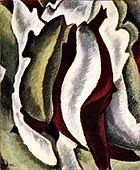
Based on Leaf Forms and Spaces, 1911–12, pastel on unidentified support (now lost)
-

Sails, 1911–12
-

Dark Abstraction, 1917
-
Thunderstorm, 1921
-
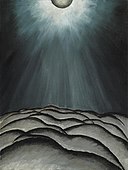
Moon and Body of water No. Two (1923)
-

Long Island (1925)
-
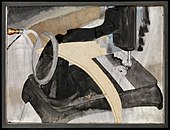
Mitt Sewing Machine, (1927)
-
Moon, (1928)
-
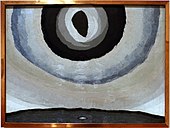
sole d'argento, (1929)
-

Dogs Chasing Each Other, (1929)
-
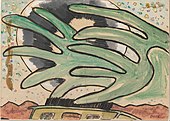
Silver Ball, Barge, and Trees, (1930)
-

Fishing gunkhole, (1930)
-

Riflessi, (1935)
-
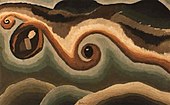
Canandaigua Outlet (1937)
-
Thunder Shower, (1940)
-
04 Per centum, (1942)
Selected listing of works [edit]
- 1910 Abstraction No. i - 6
- 1911 Move No. 1
- 1911 Nature Symbolized
- ca. 1911 Nature Symbolized, No. 2
- 1911 - 2 Sails
- ca. 1912 Institute Forms
- ca. 1912 - 3 A Walk: Poplars
- 1913 Infidel Philosophy
- 1915 Plant Form
- 1917 - 20 Gear
- 1917 - twenty Thunderstorm
- 1920 Dark Abstraction (Wood)
- ca. 1921 Thunderstorm
- 1922 After the Storm, Silver and Green (Vault Sky) New Jersey State Museum
- 1923 Moon and Sea II
- 1923 Chinese Music
- 1924 Sunrise
- 1924 "Huntington Harbor"
- 1924 Starry Heavens
- 1924 Nature Symbolized or Reefs
- 1925 The Intellectual
- 1925 Goin' Fishin'
- 1925 The Critic
- 1926 Portrait of Alfred Stieglitz
- 1927 George Gershwin, Rhapsody in Blue Part 1
- 1928 "Snow and H2o"
- 1928 Limerick
- 1928 Sea Gull Motive (also known as Sea Thunder or The Moving ridge)
- 1929 "Alfie's Delight"
- 1929 "Silver Sun"
- 1929 Foghorns
- 1929 Air current (number 1)
- 1929 Harbor in Light
- 1929 Moth Dance
- 1929 "Tree Trunk"
- 1930 - ? Brick Clomp with Landscape
- 1931 Water ice and Clouds
- 1931 Fields of Grain as Seen from Train
- 1931 Ferry Boat Wreck
- 1931 Pine Tree
- 1931 Two Forms
- 1931 Abstruse from Threshing Engine
- 1931 Steam Boat - Northport
- 1932 Gale
- 1932 Dawn Three
- 1932 Lord's day
- ca. 1933 Sun Drawing Water
- 1934 Trees
- 1934 Trees Ii
- 1934 Brickyard Shed
- 1934 - ? Sowing Wheat
- 1935 "Moon"
- 1935 "Corn Crib"
- 1935 Red Sun
- 1935 " Cow #one"
- 1935 Snowstorm
- 1935 Barns
- 1935 Tree I
- 1936 Windy Morning
- 1937 Me and the Moon
- 1937 Happy Landscape
- 1937 - ? Water Swirl, Canandaigua Outlet
- 1938 "City Moon"
- 1938 Shore Front end
- 1938 Tanks
- 1938 Holbrook'southward Bridge to the Northwest
- 1938 Swing Music (Louis Armstrong)
- 1938 "Motor Boat" Boston MFA
- 1939 Continuity
- 1939 What Harbor Worcester Art Museum
- 1940 Abstract Still Life
- 1940 Syosset
- 1940 Black and White
- 1941 Our House
- 1941 Pyramid Germination
- 1941 The Brothers #1 Honolulu Museum of Art
- 1941 Landscape
- 1941 "Neighborly Attempt At Murder" Boston MFA
- 1942 The Brothers McNay Fine art Museum
- 1942 Untitled #3 New Uk Museum of American Fine art, Connecticut
- 1943 Space Divided past Line Motive (U.S.A.)
- 1943 Dominicus
- 1943 Sand and Sea
- 1936 - 44 Burn the Sauerkraut Manufactory, Due west Ten, New York
- 1938 "Sun On The Lake" Boston MFA
- 1942 "Foursquare On The Pond" Boston MFA
- 1943 "Spring" Boston MFA
- 1944 "Dancing Willows" Boston MFA
- 1944 That Ruby One Boston MFA
- 1944 High Noon
- 1945 Figure 4
Exhibitions [edit]
- 1940-1946 Untitled from Sketchbook "Eastward" Arkansas Arts Middle American
- 1941 "Across the Road" oil on canvas Des Moines Art Center American
- 1941 "Centerport Series #16" watercolor and gouac Hirshhorn Museum American
- 1941 "Indian Summer" oil on canvass Heckscher Museum of Art
- 1943 "Space Divided" by Line Motive oil on sail Corcoran Gallery of Art American
- 1943 "Arthur Garfield Dove, Paintings 1942-43" An American Identify, New York, NY
- 1947 "Dove Retrospective Exhibition: Paintings 1908-1946" Downtown Gallery, New York, NY
- 1958 "Arthur Dove Retrospective" Whitney Museum of American Art, New York, NY
- 1971 "Arthur Dove" Galerie Ann, Houston, TX
- 1975 "Arthur Dove: Mainly the Forties" Marion Koogler McNay Art Institute, San Antonio, TX
- 2016-2018 "Making Modern" Boston MFA, Boston, MA
References [edit]
- ^ a b c d east Roberts, Norma J., ed. (1988), The American Collections, Columbus Museum of Fine art, p. 72, ISBN0-8109-1811-0 .
- ^ Me and the Moon, The Phillips Drove, Washington DC
- ^ Archives of American Fine art
- ^ Phillips Drove
- ^ a b Boston Museum of Fine Arts
- ^ a b c d e f g h i j k l chiliad northward o p q r southward t u 5 Morgan, Ann Lee (1984), Arthur Dove: Life and Piece of work, with a Catalogue Raisonné, University of Delaware Press, ISBN0-87413-222-3 .
- ^ a b c d Haskell, Barbara (1974), Arthur Dove, San Francisco Museum of Fine art .
- ^ a b c Newman, Sasha Thou. (1981), Arthur Dove and Duncan Phillips: Artist and Patron, The Phillips Collection, ISBN0-8076-1019-iv .
- ^ a b c d Depietro, Anne Cohen (1989), Arthur Dove and Helen Torr: The Huntington Years, Heckscher Museum .
- ^ a b Balken, Debra Bricker (1997), Arthur Pigeon: A Retrospective, MIT Printing, ISBN0-262-52240-iii .
- ^ MoMA
- ^ a b "Whitney Museum of American Art". Archived from the original on December xiv, 2013. Retrieved December ix, 2013.
- ^ a b c Turner, Elizabeth Hutton (1995), In the American Grain: Dove, Hartley, Marin, O'Keeffe, and Stieglitz: The Stieglitz Circle at the Phillips Collection, Counterpoint, ISBN1-887178-01-v .
- ^ Ann Landi (July 1, 2006). "Reviews: New York; Julian Hatton / Elizabeth Harris Gallery". ARTnews. Retrieved Dec thirteen, 2018 – via julianhatton.cyberspace.
an unbridled honey of pure, hot color that too recalls Gauguin and the Fauves.
- ^ a b "National Register Information System". National Annals of Historic Places. National Park Service. March 13, 2009.
- ^ James Warren (north.d.). "National Register of Historic Places Registration: Arthur Dove-Helen Torr Cottage". New York State Office of Parks, Recreation and Historic Preservation. Retrieved February 20, 2010. Run across also: "Accompanying eight photos".
- ^ "Notable Residents - St. John'due south Episcopal Church". www.stjcsh.org . Retrieved July 22, 2021.
- ^ Artnet.com Terry Dintenfass, Inc.
- ^ Shaw, David (June xviii, 2017). "Win-Win for Geneva: All 12 projects to share part of $10M grant; city to host FL Welcome site". Finger Lakes Times. Finger Lakes Times. Retrieved October 2, 2017.
- ^ Buchiere, Steve (October twenty, 2016). "Dove Block gets Landmark Society boost". Finger Lakes Times. Finger Lakes Times. Retrieved October 2, 2017.
Books [edit]
- D. Newman: Arthur Dove and Duncan Phillips, Creative person and Patron. George Braziller Inc., 1981, ISBN 0-8076-1019-4.
- Debra Bricker Balken Arthur Dove: A Retrospective. MIT Printing, 1997 ISBN 0-262-02433-0.
- Melanie Kirschner: Arthur Pigeon: Watercolors and Pastels. George Braziller Inc., 1999, ISBN 0-8076-1447-5.
- Debra Bricker Balken Arthur Pigeon: A Catalogue Raisonne of Paintings and Things. Yale University Press, 2021, ISBN 0-3002-5165-3.
Other sources [edit]
- Harnsberger, R. Scott (2002), Four Artists of the Stieglitz Circle: A Sourcebook on Arthur Dove, Marsden Hartley, John Marin, and Max Weber, Greenwood Printing, ISBN0-313-31488-8 .
- Murphy, Jessica. "Arthur Dove (1880–1946)." In Heilbrunn Timeline of Art History. New York: The Metropolitan Museum of Art, 2000–. (June 2007)
- Raynor, Vivien (October 16, 1983). "Out of History'southward Mists Comes Arthur Dove". The New York Times . Retrieved June iii, 2006.
External links [edit]
- Works past or about Arthur Dove at Net Archive
- Arthur and Helen Torr Dove papers, 1905-1975 at the Archives of American Art, Smithsonian Institution
- Arthur Dove: A Catalogue Raisonne of Paintings and Things - 2021 - Yale Academy Press
Source: https://en.wikipedia.org/wiki/Arthur_Dove






0 Response to "What Was Arthur Doves Most Famous Piece of Art"
Post a Comment